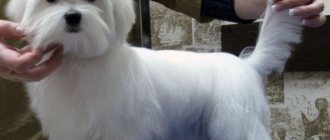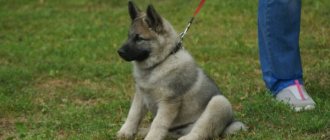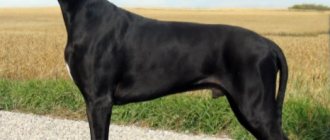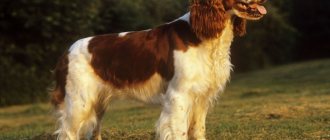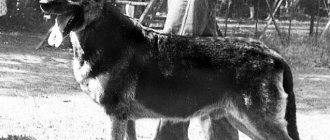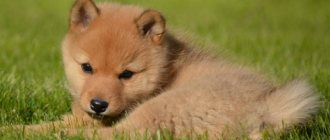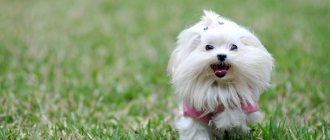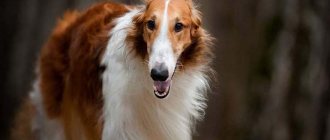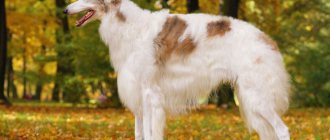Breed characteristics
| Short description | |
| Origin: | Russia |
| Conditions of detention: | House, apartment |
| Purpose: | Decorative dog, companion dog |
| Color: | Anything but white |
| Wool length: | Long |
| Adult dog size: | Height – up to 26 cm, weight – 3-4 kg |
| Average life expectancy: | 12-15 years |
| Walk: | Walking twice a day is recommended |
| Physical activity needs: | Low physical activity needs (1-1.5 hours per day of non-intensive walking) |
| Classification of the Russian Cynological Federation (RKF): | Group 9: companions and toy dogs; Section 1: Bichons and related breeds (not recognized by an international organization) |
| Puppy price: | From 5,000 to 30,000 rubles. Without pedigree - 5000-6000 rubles, pet class - 10000-12000 rubles, bril class - 15000-20000 rubles, show class - 30000 rubles |
Types of lap dogs
Setter (dog): description of the Russian breed, types
In the lapdog breed, species differ from each other mainly in the name they received depending on the area where they were bred. There are not many of them, but they are all loved by breeders and are quite expensive.
Coton de Tulear
Coton de Tulear
There is another name for the breed - Madagascar Bichon. They came to the island in the 17th century. It is believed that the ship on which the Bologneses sailed crashed near the port of Tulear. The strongest dogs reached it by swimming, survived and crossed with local mongrels.
Maximum height is 28 cm, color is white with gray or ash-colored spots. The coat is very long, thick, wavy. The paws are short and thick. Incredibly loyal dogs that will follow their owner to the end. Thanks to their ancestors, who had to survive on the island, they can still show hunting instincts. Able to adapt to the owner of any temperament. They will happily play with children, sit with elderly people, run happily on walks or lie down all day.
Important! The main thing is to start training and raising the Coton de Tulear in a timely manner, otherwise they will become withdrawn and will not make contact.
Russian Tsvetnaya lap dog
This breed appeared in Russia thanks to the crossing of Bolognese, Shih Tzu and Lhasa Apso. Breed Features:
- height at withers does not exceed 25 cm;
- maximum weight 5 kg;
- there is almost no hair on the face;
- The color of the lap dog can be brown, black, beige or gray. White color is considered a defect;
- The coat is long and curly.
Interesting! Russian lapdogs are recognized as the hardiest of all varieties.
Russian variety
Small lion dog (Levchen, Bichon Lyon)
This is the most original of all types of lap dogs. It is believed that they appeared a long time ago, back in the 2nd century. as a result of mixing Epagnoles and Great Danes. The dogs were not in great demand, and therefore by 1960 their numbers had sharply declined. They were included in the Guinness Book of Records as the rarest breed.
These are relatively tall dogs - up to 32 cm at the withers. The coat is straight, long, fluffy. Colors: black, red with white stripes, gray, piebald. They are given a special haircut so that they resemble lions: the head, tip of the tail and paws are left fluffy, and the whole body is naked. Dogs have a good character, they become real members of the family, easily getting along with everyone. They lend themselves well to education and training.
Important! French dog breeders are working to improve the appearance of the lion dog in order to bring it closer to the appearance of the very first levchens.
Bichon Frize
Their ancestors are water spaniels. These lapdogs are curly, incredibly smart, and white in color. The maximum height at the withers is 30 cm. The color is white, but red spots are appropriate for puppies, which disappear as they grow older. Puppies of this variety were originally bred only for noble people; ordinary people could not purchase such a dog.
Interesting! A light-colored, curly coat is needed to repel the sun's rays and not accumulate heat.
Havanese Bichon
The Havanese Bichon (Havanese) is the result of crossing poodles, Bichon Frize and common Cuban mongrels. The breed was only recognized in 1996.
Description:
- height up to 25 cm;
- ears droop, tail thrown back;
- The Havanese has an interesting coat color - spots of brown and black are scattered on the main white background.
The character is friendly, calm, they love children and enjoy spending time with them. Bichons are great at bonding with other pets and even strangers. The main thing is not to spoil this dog, otherwise it will begin to feel like the master of the house and will stop obeying.
Interesting! There are legends about the Havanese Bichon. It is still believed that it brings peace, mutual understanding and prosperity to the home.
Havanese
Maltese (Maltese)
Maltese is a white lapdog, the ancestor of all other varieties. Her fur is very long, straight, only snow-white in color. Any additional inclusion is considered defective. Main characteristics:
- height at withers does not exceed 25 cm;
- weight 3-4 kg;
- sharp mind, friendliness;
- love for children;
- fast training;
- hypoallergenic.
Maltese are attached to all family members, they need company all the time, they cannot stand loneliness. Therefore, these fluffies are not suitable for people who spend a lot of time at work. They love to bark a lot and loudly, they are very selective in their choice of food, they love tasty things, but you should not spoil them, this can lead to obesity.
Maltese
Bolognese (French lap dog)
The Bolognese is the result of crossing a Maltese and a miniature poodle. Height at withers – up to 27 cm, weight up to 7 kg. The coat is very long and wavy. Character traits: attachment to a person, jealousy, shyness.
Dwarf Maltese
This baby is not recognized by the standards. She was bred as a subtype of Maltese and is not allowed for exhibitions. However, breeders love her very much. A characteristic feature is its miniature size: the weight of such a dog is only 2.5 kg. Particularly popular are individuals with a “baby face”, which have large eyes and an upturned muzzle.
Important! This appearance is officially rejected and is considered a breed defect, since such individuals are prone to various diseases and injuries.
Dwarf Maltese
Italian lapdog (bolognese)
Main characteristics:
- height at withers up to 30 cm;
- weight up to 4 kg;
- the coat is long, very thick, the dog looks shaggy;
- The color is only white without impurities.
The only purpose of pets is to be companions to people. Therefore, the character is appropriate: affectionate, good-natured. Animals are very obedient, smart, love to spend a lot of time with people and play with children.
Italian bolognese
Japanese lap dog
The Japanese Bolognese is often referred to as the Japanese Chin, which resembles this breed in appearance. But of course there are differences. From the general: miniature (about 25 cm at the withers), ears, dark eyes, head shape, long coat. The differences are in the structure of the body: chinas are more elongated. The dogs have a tail on their back, and the color is never monochromatic. It must be either white-red or white-black, and there must be a white stripe from the nose to the forehead.
Scottish lap dog
There is no officially recognized Scottish breed. As in all countries, these dogs are crossed with other breeds, but so far there is no result.
Shih Tzu
History of the origin of the species
The history of the breed is short and not rich in historical facts. The fact is that decorative breeds were not popular in Russia until the Second World War. All dogs were useful on the farm and carried out working functions.
Since the 45-50s, when fashionistas began to be interested in Western culture, the first ladies of the USSR received rare copies of Lapdogs from abroad. The quality of further breed lines in Russia was terrible. Then it was decided to breed a new dog. The clubs were created on the basis of nurseries for hunting and service dogs.
In 1951, the first black puppy named Tim-tim was received. His parents were white and coffee lapdogs. In addition to them, Shih Tzu and Lhaso Apso took part in further selection. Puppies that matched their phenotype and color were selected.
By the end of the 50s, the line was formed. In 1999, the first breed club in Russia was created and a standard was published. Unfortunately, the Tsvetnaya lapdog has not yet received international recognition.
Types of lapdogs
Maltese
This species is the most popular not only among lapdogs, but also among all decorative dogs in general. The Maltese (or Maltese) dog is characterized by a long coat of white or ivory color. During the time of the Chinese emperors, they were considered "royal" dogs. The breed itself is unpretentious. Due to the length of the coat, it requires constant care, which can be easily done at home. With proper care, it practically does not shed. The dog has an obedient and good-natured disposition.
French
The peculiarity of this breed is its curly white coat, which grows throughout the animal’s life. Therefore, it requires special careful care. Individuals participating in exhibitions need systematic visits to grooming salons and professional care throughout their lives. Another distinctive feature is the black expressive eyes, revealing the curiosity of the owner.
The historical roots of this type of lapdog go deep into the past. Despite the passage of centuries, the modern appearance is little different from its ancestors.
Havanese (Havanese)
The breed is relatively young, bred in Cuba. It is quickly gaining popularity around the world. The Havanese is a glamorous breed, sought after by wealthy people. Due to the need to live in comfortable conditions, inherent at the genetic level, it is not suitable for the average person or for people who do not have the opportunity to devote sufficient time to proper care and high-quality nutrition.
The appearance of a pet, just looking at it, evokes an irresistible desire to stroke its soft fur, pick it up and enjoy the sight of its charming face.
The Havanese dwarf dog is very good-natured, easily gets along with people and other inhabitants living in the house and meeting on the street while walking. They are absolutely alien to aggression and irritability. They need protection from the unfriendliness of other animals and people.
Russian Tsvetnaya lap dog
A distinctive feature of this species is its unusual coat color. Unlike the white color of other species, it has all shades of beige, gray and brown. The smallest white spot is classified as a defect. The breed was bred in Leningrad and for a long time was not officially recognized due to the admixture of poodles and Shih Tzu. It was recognized only in the 60s of the last century. Another unusual trait for lap dogs is the guard instinct. The dwarf dog rushes at anyone if it feels a threat to its owner. In everyday life she is quite friendly, flexible and compliant.
The disadvantage of the breed is that it does not get along well with very young children and is intolerant of loneliness. The dog should not be left alone for a long time; it may become depressed, melancholy or angry. Constant company needed.
Italian (bolognese)
Purebred representatives of this breed have a snow-white color that does not allow any spots. These are true aristocrats with a wayward temperament. Outwardly proud, they constantly require attention and increased care. Back in the twelfth century, these mini-dogs were in great demand in the homes of Italian aristocrats and were decorations for rich ladies and were presented as gifts.
We advise you to read: Entlebucher Sennenhund Dog Breed
Externally, Italian lapdogs, due to their fluffy fur that hides their graceful body, resemble a round soft lump.
Bologneses are very susceptible to injury due to their small size. For this reason, it is not recommended for families with small children. The breed has good health and, with proper care and maintenance conditions, has a long life expectancy, from 14 to 18 years.
Distinctive features
A small decorative dog of a stretched format, height at the withers – up to 26 cm, weight – up to 4 kg. A distinctive feature is the colored coat, while most lapdogs have white fur. Russian lapdogs are curly-haired with a thick coat, somewhat similar to small sheep.
Since the breed has not yet been accepted by international canine organizations, the standard is being written and amended in Russia. The last changes were made in 2010. All unsuitable puppies are discarded.
- The head is small, but proportional to the body, with long, thick hair. The skull is rounded, convex with a pronounced occiput and brow ridges. The stop is clearly outlined and not long.
- The muzzle is shorter than the head, not flattened, tapering towards the nose. The bridge of the nose is straight. The jaws are wide, with a scissor bite The lips are dense, thin, black.
- The nose is small, triangular, black;
- The eyes are medium in size, set wide apart, above the stop. Dark and light iris colors are allowed.
- The ears are set low, short, triangular, hang on cartilage and fit tightly to the head. Decorated with wool.
- The body is compact, rectangular. The back is long and straight. The loin is short and convex. The croup is sloping and strong. Chest of medium depth and width. The belly is tucked in. The neck is not long, but the set is high.
- The tail is not long. Throwed onto the lower back, can be twisted into a ring. Well covered with long hair.
- Limbs are parallel, set moderately wide and straight. The paws are round with pointed toes. Movements are easy.
- The coat is long, harsh, thick with a dense undercoat. The best form is large individual curls, curls.
- Colors: any colors except white.
Description of the breed
The breed has certain characteristics, despite the diversity within it today.
Colors
This dog is famous for its fur. It is easy to understand from the name of the breed that the Russian colored lapdog is distinguished by a luxurious palette of colors.
Meet:
- Black;
- Fawn;
- Gray;
- Delicate creamy;
- Redheads;
- Black-and-white;
- Brindle;
- Brown.
You will also find decorative dogs with tan marks; the dominant colors are gray and black. But remember that spotted or white dogs do not fit into the breed standards, so they will not be able to participate in exhibitions. But small white markings on the chest and toes are acceptable (though not desirable).
Proportions
The lapdog is a small, proportional dog with a slightly elongated body. She looks harmonious thanks to her strong bones and dense curly coat. The pet's head is proportional and of medium size. The neck is set high and does not differ in either width or length. The dog's chest is deep, the withers are moderately expressed. Small parallel paws give the Russian Colored a light gait. Due to its successful build, the dog moves freely and gracefully.
Weight and height
The desired height does not exceed 26 centimeters, but overly small decorative dogs are not welcome. The weight of both males and females does not exceed 4-6 kilograms.
Breed standard
For Russian coloreds there are strict norms of proportions and color. The following are considered categorical defects: a short tail, lack of growth on the face, underbite and other dental defects, white marks occupying more than 1/5 of the body. Here are the strict requirements for a dog’s constitution:
- The height of a typical Russian lap dog does not exceed 20-26 centimeters, and the weight ranges between 1.5 and 4 kilograms;
- The muzzle is one third of the length of the head. The skull is rounded, convex, and the occipital protuberance is lost against the background of the muzzle. The lapdog has a scissor bite, the teeth are white and miniature. The color of the head can be black or the color of the coat;
- The dog's skin is elastic and soft, the coat varies in the number of curls. The skin is shiny, and the silky hair is long and thick. Colors allowed for representatives of the breed are all except white. It is important that the color is solid; spots are not allowed by the standards;
- The eyes are round and dark, the ears are set high. They have the shape of a rounded triangle and hang on cartilages;
- The back with a short loin is flat and wide. The stomach is tucked, and the chest is elongated and sloping. The joints are strong and resilient. The hind legs are arched and slightly smaller than the front legs.
Photo of an adult dog
Photos of puppies
Features of character and behavior
The character of Colored lapdogs can be described in one word – “family-friendly”. This dog will be happy to spend all his time surrounded by a loving, noisy family. He will give all his love and devotion to his household and will warm you with his warmth.
The breed is calm and unobtrusive, they sense the owner’s mood and will not get in the way. In addition, Lapdogs are flexible and can make friends not only with any person, but also with any pet. They have practically no downsides.
Bolonka - character
The lapdog is a very touching creature, incredibly charming, which will melt the heart of even the most callous person. She has a kind and cheerful character. He is distinguished by touchiness and vulnerability, needs love and constant attention from all household members. He is a children's best friend and will never cause harm under any circumstances. Living in a large family, these little four-legged animals give vibes of joy to every family member every second.
We advise you to read: South African Boerboel Dog Breed
Advantages
The breed has many advantages. Owners, for the most part, do not even know what negative aspects lap dogs have. In fact, it all depends on upbringing. In general, the Russian Tsvetnaya lapdog breed was bred as an easygoing small decorative dog with a gentle character and lack of aggressiveness. In addition to these positive qualities, you can add the following advantages:
- Devotion, love, affection;
- Playfulness and energy (dogs remain active until old age);
- Lapdogs love children and people around them, treat other animals well, and even get along easily with cats;
- Dogs adapt to the rhythm of their owner’s life and sense his mood;
- Strong build (for a decorative dog, Colored lapdogs are very strong);
- Bravery and courage (they have protective instincts, they can bark at strangers, protecting their owner);
- High intelligence and ability to train;
- Cute original appearance, no shedding;
- Suitable for apartment living.
Flaws
Among the shortcomings of the breed, one can highlight only intolerance of loneliness. The dog begins to miss its owners and mope. Such pets are ready to literally follow the heels of their household members and accompany them on trips.
They can be quite naughty and spoiled, but this only occurs in the absence of upbringing. The dog's behavior always depends on the family.
Character and psychological portrait
Russian colored lapdogs are very sociable, friendly and affectionate, but are by no means intrusive. They make it easy and interesting. These dogs get along well in families with children and adults, and are perfect for a lonely person. The presence of another animal in the house will not be a hindrance, with which the lapdog will definitely try to find a common language, unless of course the neighbor does not mind. Conflict or competition usually manifests itself only when dogs of the same breed are kept in a pack.
The colored lapdog is miniature and defenseless, she understands this and will not get into trouble, but at the same time the dog is quite brave and behaves with dignity among its larger brothers.
The lapdog is usually very picky in its likings and chooses its favorite among close people. Very attached to the owner, but not to the place, easily adapts to new conditions, and is always ready to travel.
Despite many similar temperamental traits, the Russian lapdog is still too diverse. Each individual dog has its own distinct individual character.
Care and maintenance
The advantage of this breed is that it is easy to maintain. Lapdogs do not shed and do not emit odors. Their coarse coat does not require daily brushing. They are also not bathed as often as other decorative dogs.
Dogs can only live indoors. They feel great in urban apartment conditions because they do not take up much space. The climate does not particularly affect lapdogs. Firstly, they were bred in St. Petersburg, which is famous for its damp weather, and secondly, they have a thick coat. However, on hot days it is better to avoid direct sunlight.
Usually, owners allow lap dogs to sleep in their bed, although this is not correct in terms of upbringing. Miniature dogs can be trained to go to the indoor toilet, but walking them will be good fun.
Before buying a puppy, you need to take care of its place in the house: purchase a bed, bowls, toys, tray and hygiene products.
Nutrition
Bolonki are small dogs and do not require a lot of food. In addition, excess nutrition will lead to obesity and digestive system disorders. Feeding small breeds is usually taken much more seriously than feeding large dogs. There are a lot of prohibitions that are not recommended to be ignored:
- You should not give your dog bones, even raw and large ones;
- You cannot feed your pet from the table or encourage begging;
- Your pet does not need starchy citrus fruits and exotic vegetables and fruits (potatoes, melon, grapes, oranges, kiwi, tomatoes) in their diet;
- Flour and confectionery products are prohibited.
If the puppy was fed dry food at the kennel, then it is better to continue feeding it with food from this company. If the owner is not satisfied with the composition, then the dog can be switched to another food. This needs to be done gradually.
For Colored lap dogs, holistic (grain-free food) of super-premium class with small granules (for small breeds with average activity) is suitable. An adult dog needs 200-300 grams of food per day, diluted with water or broth.
With a natural diet, the menu must include meat (chicken, beef, rabbit, but not pork); it should occupy the bulk of the diet. In addition to it, cereals (porridge), vegetables and fruits, dairy products and eggs are mandatory.
Adult lap dogs are fed 2 times a day (morning and evening). Puppies more often - up to 2 months - 5-6 times a day, up to six months - 4 times, up to a year - 3 times.
Health
It is not yet possible to say exactly how healthy the breed is. Not only are dogs not yet recognized by a world organization, they haven't been around long enough. Perhaps the long journey of subsequent selections will change the condition of the breed. At the moment, Bolonki live about 12-14 years and do not have particularly pronounced genetic diseases.
The health of a pet most often depends on care and nutrition. If the owner follows the vaccination calendar, diet and care schedule, the dog will live a long time.
Vaccinations
All puppies, regardless of breed, must be vaccinated. This is done when maternal immunity ceases to function (1.5-2 months). Typically, nurseries take care of the first vaccination and obtain a veterinary passport. The owner must follow the vaccination schedule:
- Vaccine against infectious diseases (enteritis, plague, influenza, etc.) at 1.5-2 months, repeated after 2 weeks, at 6 months, at 12 months and annually;
- Rabies vaccine at 7 months and annually.
Even if the dog is an indoor dog and does not go for walks, vaccination is necessary. A person is capable of carrying millions of living organisms, including viruses, on clothes and shoes. To protect the puppy, it is important to carry out vaccinations on time and follow some rules.
The dog must be absolutely healthy. All vaccinations are carried out by experienced specialists; in case of an allergic reaction, they are able to save the animal. Before the procedure (two weeks), the pet is dewormed using medications. After each vaccination, it is necessary to maintain a two-week quarantine to develop immunity.
Puppies and pregnant bitches are most susceptible to infectious diseases. Such pets should not be introduced to dogs, because the risk of contracting the virus is high. Even vaccinated pets are not completely protected from infection.
Diseases
Colored lapdogs are a new breed line, the health of which is still difficult to judge. So far, there are not even breed-specific diseases to which these particular dogs are susceptible. It can be predicted that due to their small size, lap dogs will develop diseases of the joints and muscles.
Like all small breeds, they can develop digestive problems. In addition, they are susceptible to severe tearing and conjunctivitis. Breeders mention tartar and gum disease.
One way or another, most diseases appear due to improper care and lack of necessary vaccinations.
Walk
Although these dogs are intended for apartment living, they need walking just like other pets. Twice daily walks of 20-40 minutes are suitable. Lapses enjoy the company of pets and people, so playing outdoors with other animals will be good fun.
Puppies begin to be walked after the second vaccination. Small dogs should be accustomed to regular outdoor toileting and a leash. The pet must know its name and the voice of its owner, only then will it be able to walk freely.
Lapdogs show good results in agility, so you can take them to dog parks where there are special obstacles. In dirty and cold weather, dogs are dressed in protective overalls and raincoats.
Grooming
Lapdogs have long, thick, curly hair, the condition of which needs to be monitored.
- They do not shed, so you need to comb them 3-4 times a week, removing tangles and knots. You can pick up a brush at any pet store, preferably with long metal teeth.
- In the summer, animals are cut ; the standard does not provide for grooming, but for the convenience of the dog and the owner, this can be done.
- They are bathed 2 times a month with special shampoos for long-haired dogs. If the dog gets dirty, you can rinse it in warm water.
- Paws are washed after every walk. Drying wool is required.
- To the eyes from watering, the fur on the forehead is tied into a ponytail. Wipe mucous membranes daily.
- The ears are examined a couple of times a week.
- Teeth are brushed with a special paste or cords 2-3 times a month. Nails are trimmed and filed as they grow.
During the summer and spring periods, the dog must be treated for fleas and ticks. Don't forget about deworming medications.
General rules for cutting lap dogs at home
In terms of haircuts, there are no special differences between the standard and Maltese mini, so we will not separate them in this article. The Maltese dog needs to be taught hygiene procedures from childhood. Reward your puppy with treats after brushing or trimming his nails. As an adult, such a pet, whatever its character, will react more calmly to the actions of the groomer or owner.
The puppy is most easily accustomed to hygiene procedures at the age of 2-3 months.
Preparing for a haircut
- take your pet for a walk so that he can empty his bladder, play with him;
- untangle or cut out all tangles;
- wash the animal with shampoo, then treat it with balm or special oil;
- dry the dog with a hairdryer;
- Comb again.
You can only trim completely dry hair, as wet scissors will dull faster. Place the dog on the grooming table and secure it. Grooming usually starts from the animal's muzzle, with the scissors going away from the eyes. It is more convenient to process large parts of the body with a machine.
It is better to have an aggressive dog groomed by a professional groomer. The specialist has extensive experience in dealing with difficult animals and will be able to stop unwanted behavior.
During the haircut, behave with restraint, do not shout at your pet. If the dog has never been to hygiene procedures before, then it may experience stress. Try to calm your pet down with a gentle voice or by giving him treats.
Mating
Official mating must take place under the patronage of a nursery . To do this, dog owners sign and fill out a special form indicating the date. Both pets are checked and disinfected. The owner of the dog sets the price. Usually it is equal to one puppy or a percentage of the cost of the dog. If the female does not become pregnant, mating is not paid.
Bolonki become sexually mature at 10 months, but the most favorable period for mating is 2 years. During heat, the girl should show some signs indicating readiness: loosening and softening of the loop, clear discharge and playful behavior.
The female is brought to the male dog’s territory so that the boy feels confident and knows that this act is carried out only in his home . The animals sniff and get to know each other. After which the girl will allow you to do the cage. If there is no lock, there is no need to worry, this does not mean that the female is empty. Repeated fastening is carried out after 48 hours.
Key points in training
These dogs are very smart and easy to educate and train. Unlike Yorkshire Terriers, they are not prone to dominance and manipulation of their owner. But you still need to raise a puppy, showing that the person in the house is in charge . Rough methods must be eliminated. A motivational training session or game is best.
Although this breed is miniature, it should not be allowed to sleep or jump on human furniture. Also, the pet should eat only after the whole family. Begging is stopped and punished.
Colored lap dogs cope well with agility and perform in various competitive programs. They enjoy training with their owner. By 4 months, the puppy should learn its name. From now on you can start learning basic commands.
Read about how to properly train a dog in the article: “Training a puppy: effective methods from dog handlers, learning commands at home.”
How to choose a puppy
The Russian colored lapdog is not recognized by the international cynological organization, so purchasing a puppy is not an easy task. There are not many official nurseries in Russia that breed the breed. Buying a puppy from a private person does not always guarantee the health of the pet, but it may be cheaper.
- The breeder must provide all the necessary documents and tell the future owners everything about the breed line and the dog’s parents. He has the right to refuse a sale if he believes that people will not be able to care for the animal.
- Before purchasing, owners must decide on the gender and class of the dog . Bitches are more flexible and can bear offspring, males are more active and playful. If the pet is purchased as a pet, then a pet-class puppy is suitable, but if for exhibitions, then a show-class puppy.
- Healthy dogs will be active and inquisitive. The one who pays attention to the people who come first, as a rule, becomes the most devoted friend. The cost of lap dogs depends on their class and varies from 5,000 to 30,000 rubles.
A dog, even one as small as a Russian Tsvetnaya lapdog, is a big responsibility. The decision to purchase should be made by the whole family. This dog will be able to give all his love and devotion, but will require a lot of attention in return.
Choosing a puppy and price for a Russian Tsvetnaya lapdog dog
A really good puppy can only be purchased in a few nurseries scattered mainly in large cities. The main population of Russian colored lapdogs today is concentrated in Moscow, with slightly fewer dogs in St. Petersburg. There are separate nurseries in many large cities of Russia and the CIS countries.
The breed group is developing at a rapid pace, but has not yet reached the level where all the babies in the litter more or less meet the standard. Puppies are often born with obvious differences in constitution or coat quality. A lot of dogs are rejected from breeding, despite the fact that they were obtained from good parents with a typical appearance. Those wishing to buy a Russian colored lapdog puppy will most likely not have to wait long, unless there are special requirements for gender and color.
A Russian colored lapdog puppy not for breeding costs from 20,000 rubles. Promising puppies can cost significantly more, usually from 40,000 rubles and above.
